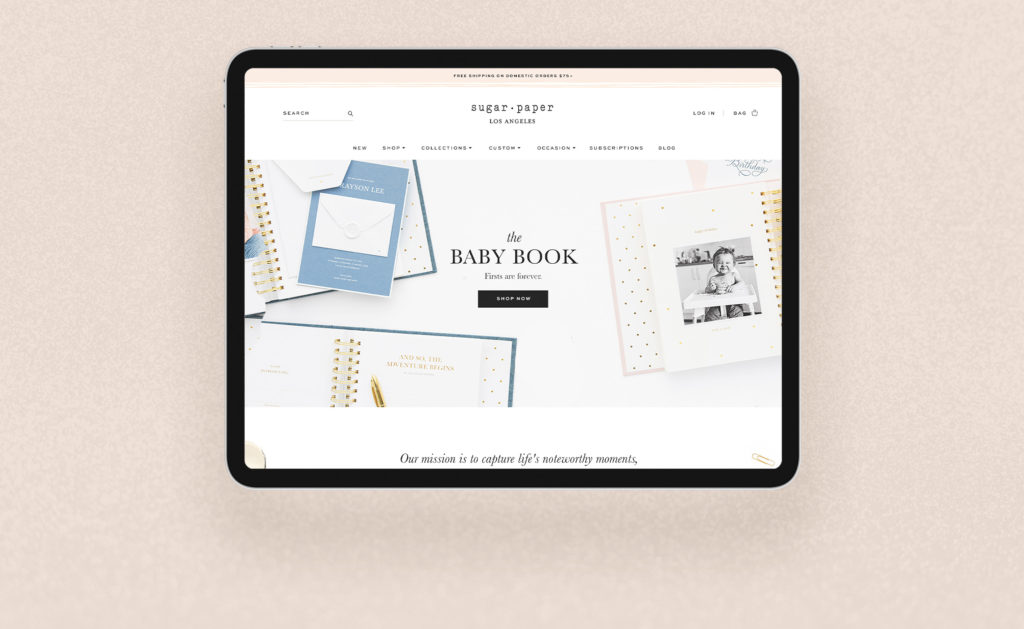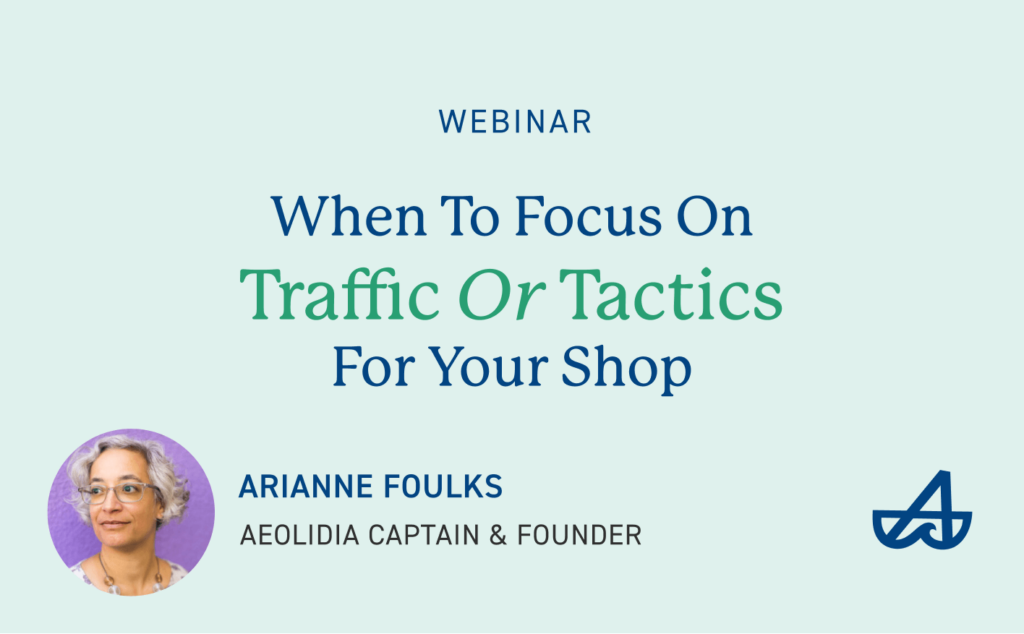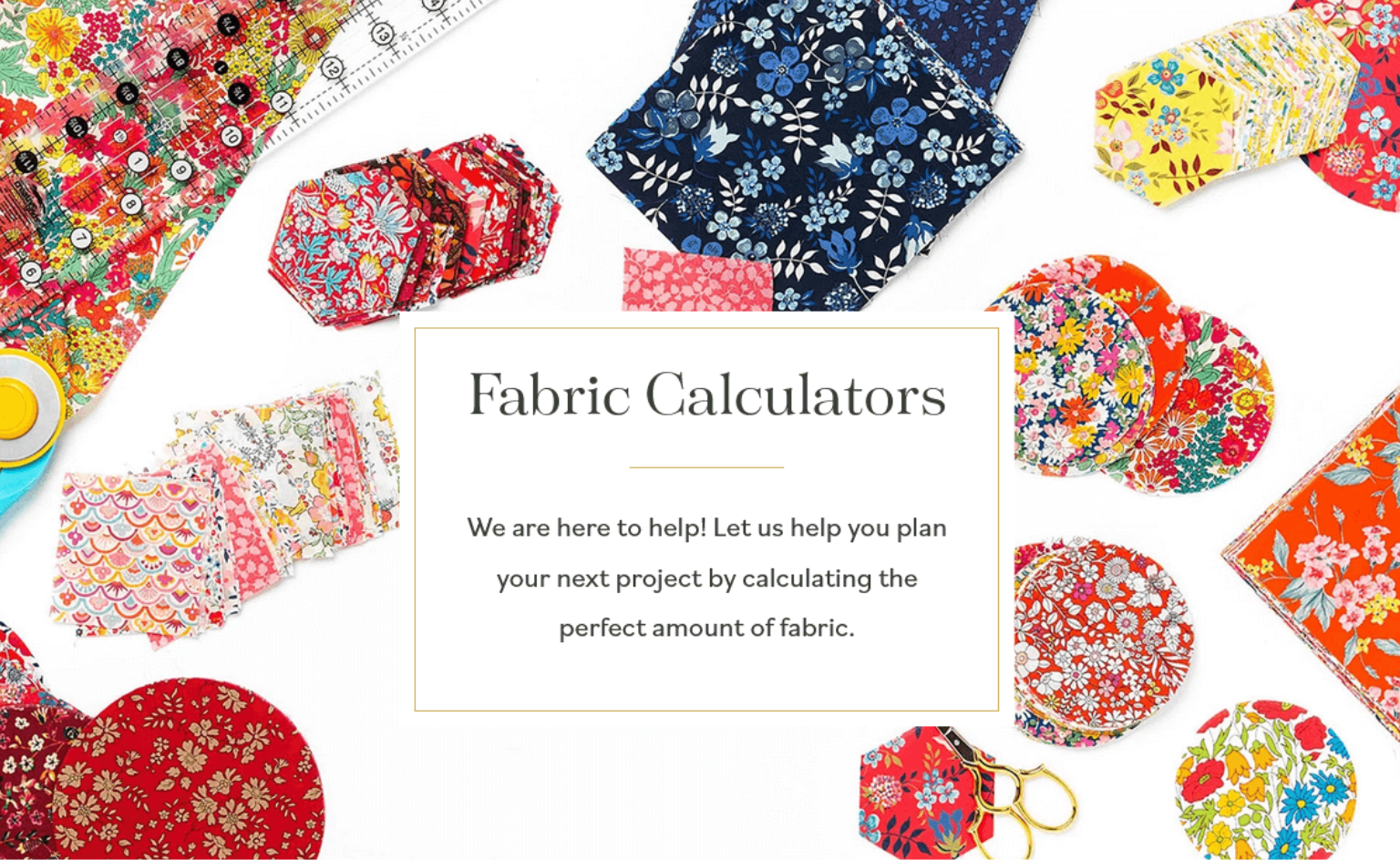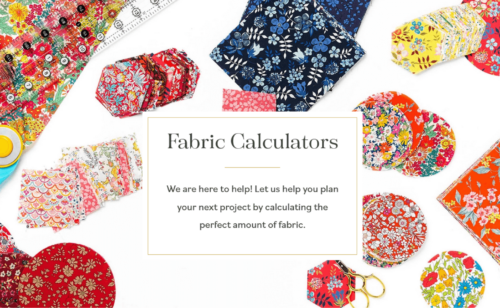
If you have an ecommerce website and feel that you should be getting more sales from it, this article is for you. Are your shoppers dropping out before checkout or bouncing off the home page without exploring further? Do you have a lot of abandoned carts? Are you wondering if you need a better website, or if you just need more visitors? Help is here! Today I’m sharing some of my top tips to help you improve ecommerce conversion.
Let’s dive in!
Bring quality, targeted traffic to your online shop
It can be very puzzling to figure out how to get people to visit your site, especially if you’ve been relying on a service such as Etsy to drive traffic to you. Once you have a website of your own to promote, you need a plan to reach out to all the right people.
Many of our clients run creative businesses that are so unique and out of the mainstream that they’re going to want highly targeted traffic – meaning visitors who understand the type of business they are, and who are looking for the kind of stuff they sell.
The more unique or niche your business is, the more carefully you’ll want to target your marketing efforts. Generally, it’s easier to distinguish yourself by not appealing to the masses, and instead speaking to your own group of like-minded people. Here are some pointers to help you bring targeted traffic to your shop.
Understand your target audience
Spend some time in your customers’ shoes and find out what blogs they’re reading, what hashtags they’re following, what Pinterest boards they build, and what language they use. This will allow you to do the right thing when trying to attract them. Here are some things to know before you start marketing your products or services:
- Who is my target customer?
- What problem can I solve for my target customer?
- What desires can I fulfill for my target customer?
- Where does my target customer hang out?
- How does my target customer communicate?
- What motivates my target customer to make a purchase?
Make a plan to attract the right people
Understanding your target customer will help you determine what blogs to pitch to, what sites to advertise on, what keywords to pay for, what offers to make, and what collaborations to pursue. Here are some ways to apply your research:
- Search engine optimization (SEO): Optimize your website for search engines, including keyword research, on-page optimization, and link-building.
- Retargeting ads: Use Google’s retargeting ads to advertise to people who have already visited your site and are likely to be interested. This is the best quality traffic!
- Content marketing: Leverage valuable content to attract and engage your target audience by blogging, guest posting, social media marketing, and video marketing.
- Influencer marketing: Collaborating with influential individuals or brands in your industry to expand your reach, build credibility, and attract high-quality traffic.
For weekly tips like this, subscribe to our newsletter
"*" indicates required fields
Enhancing ecommerce conversion rates
Once you’ve attracted potential customers to your ecommerce store, the next crucial step is to optimize your conversion rates. So, what is a conversion rate, anyway?
Your conversion rate is the percentage of visitors to your site that convert into customers, by making it all the way through checkout and purchasing from you. If 1000 people visit your site and you get 20 orders during this time, this would be a 2% conversion rate, which is considered pretty standard for ecommerce sites.
(Number of sales you got) ÷ (number of visitors you had) = Your conversion rate for that time period
You can work that number backward to help you with your goal. How many sales did you want in a day (week, month)? If you want 20 sales, you need 1000 visitors – if your site and customers are average. You may have an amazing site or a truly engaged audience, and so you will need fewer visitors to get 20 sales.
(Number of sales you want) ÷ 0.02 = (Number of visitors you need)
If your ecommerce software shows you good conversion stats, you’re all set and don’t need to do extra work. A nice thing about the Shopify stats is that they show you step-by-step where you’re losing people and can be helpful in determining where the sticking point or roadblock is.
If that info isn’t prepared for you, you will need to check your web stats and compare them to your sales. If your ecommerce software or web host provides great stats, use those, otherwise, most people will be using Google Analytics to do this. Your best bet is to set up Ecommerce Conversions in Google Analytics, but if you don’t yet have that set up, there is a simple way to grab your numbers.
Log into Google Analytics to find out how many unique visitors (this means actual people, not multiple visits from one person) you had during the period of time you’re tracking. Once viewing your stats, go to the Audience link, and click Overview. Adjust the calendar using the date tool on the top right, and look for the number next to “Users”.
If you don’t have any kind of stats for your site, sign up for Google Analytics now, and get that code on there! Wait a few days, and then start seeing what’s going on.
Take your number of sales for any given period, and divide it by your unique visitors (not your total page loads, but the actual people on the site – the “users” number in Google Analytics) to find out your conversion rate, as explained above (Basic Conversion Rate Math).
(Total sales) ÷ (Number of visitors) = Your conversion rate
How do I interpret my conversion rate?
Here’s where things can get messy. All you have is numbers here. You aren’t thinking about where these people came from, why they’re on your site, what they’re looking for, or how well your product meets their needs. Realize that you don’t have a full picture when you’re doing this kind of mathematical analysis, and don’t expect a clear answer with an easy solution.
Before you start getting into the math of website conversion, get clear on what you need (the minimum amount of sales to be able to turn a profit) and what you want (the number of sales that you’re aiming for to be able to grow the business to where you want). You can then take that range and see what can be changed to get there.
With your number and your goal, it is easy to decide broadly where to focus your efforts. For example, if you’re getting 25 visitors a day, don’t expect many orders. Fiddling around with your website is going to be a waste of your time. You need to focus on getting more people to the site, above all else.
If you’re getting thousands of people to the website each day with not enough sales, then don’t worry about increasing your marketing efforts right now, but instead figure out how to fine-tune your website so that people will purchase.
If you are somewhere in between, for instance, the amount of visitors you get isn’t pitiful, but also isn’t impressive, my instinct is to bring more people in and see if it leads to enough sales. If not, you now have a nice stream of people to test out some website changes on.
Tackling low ecommerce performance
Low ecommerce performance can be a frustrating roadblock for any business. Let’s take a look at the wide variety of things that might be contributing to a low conversion rate.
Low ecommerce conversion rate: when the problem is your product
Maybe your website is great, but your product is just plain hard to sell. Here are some reasons that might be:
- Products that take work on the customer’s end. For instance, if you sell a personalized product based on your customer’s photo, you’re asking them to do a lot of work to place the order. They may put it off or decide not to do it at all. Can you think of some ways to make the customization process easier for your customers?
- Products that appeal to the other senses. Do you have a product that people need to touch, smell, or taste to know if they want it? You need to work hard to get past those barriers online. Samples, testimonials, videos, a satisfaction guarantee, beautiful photography – all these things could help.
- Non-impulse buy products. Maybe you sell a luxury item with a high price point. Or an enormous item that is complicated to ship. If the purchase feels daunting to your customer, you’ll need to work harder than a business that sells products that are easily purchased on a whim.
- There isn’t a large enough market for your product. Perhaps your product is so niche that you aren’t able to find enough of the right people to want to buy it. In-person sales at markets or fairs can be a great way to validate the market for your product.
Low ecommerce conversion rate: when the problem is your checkout process
Here are some choices you can make about checkout that can affect how easily your customers make it to the other side.
- Shipping options & cost. Shipping that customers perceive as being too much is one of the top reasons people will abandon their shopping carts online. If you have any way to get shipping costs down, it can be a huge help. They decide how much they want to pay for your product when you set the value on the product detail page. Then, when it suddenly costs more at checkout, it can feel like too much.
- Payment options. You want to be sure you offer payment options that your customers really use. For instance, if you only offer PayPal, you could be losing a lot of people who don’t use that service.
- Ease of checkout. If you require customers to create an account, have a complex checkout process, or there is anything on the path to purchase that could confuse or distract your customers, you are losing some people.
Low ecommerce conversion rate: when the problem is your website content
Maybe your website design and layout is fine, but your content is not doing its job. Your photography and all the text on your site need to interest people, draw them in, and be the next best thing to seeing your product in person and trying it out. Consider the quality and desirability of your:
- Product photography
- Product descriptions
- The story you’re telling about your business
- Home page text
- Video content
Low ecommerce conversion rate: when the problem is your marketing strategy & traffic sources
When driving traffic to your site, you can be broad or you can be targeted. Being targeted is generally regarded as a smart method, and if you’re talking just to your perfect niche of people, your conversion rate will be high. Those people already get it, and need less convincing.
Getting a small amount of targeted traffic can give you more sales than getting a medium amount of less targeted traffic. But! Getting a high amount of less targeted traffic can also be great for your business.
For instance, search engine traffic to my site, aeolidia.com, has a terrible conversion rate (compared to my other traffic streams), because many of those people aren’t in my niche of just-right people. If you get a lot of search engine traffic, you might be seeing a low conversion rate, too.
But Google sends me so much traffic that it’s okay that the conversion rate is low because the overall number of people who convert is good. Even if Google is your lowest converting stream of traffic, it could make you the most money. And since search engine traffic (once you’ve built it up) doesn’t really cost anything or take any maintenance, you may be very happy with your low conversion rate.
Low ecommerce conversion rate: when your problem is your website itself
Of course, it will be harder to sell even the most amazing products from a website that’s not user-friendly. If people don’t immediately get what’s going on when they see your site, if it’s not mobile-friendly, if the layout is confusing–these are all things that could be losing you sales.
- Analytics and data-driven insights: Utilizing website analytics tools to track key performance indicators (KPIs), identify bottlenecks, and make informed decisions to optimize performance.
- Cart abandonment recovery: Strategies to combat cart abandonment, such as implementing exit-intent pop-ups, personalized email follow-ups, and offering incentives to complete purchases.
- Customer retention and loyalty: Building long-term relationships with customers through loyalty programs, personalized offers, excellent customer service, and post-purchase engagement.
- Streamlining the checkout process: Simplifying the checkout process, reducing steps, and offering guest checkout options to minimize friction and increase conversion rates.
Traffic or Tactics?

Diagnose your shop’s growth & sales needs and stop leaving money on the table.
Related Posts
Let's take your online shop to the next level
The Shopify websites we design have a reputation for substantial improvements to ecommerce conversion rates and online sales. Let's talk!
















1 thought on “How to Boost Traffic and Drive Sales to Your Online Shop”